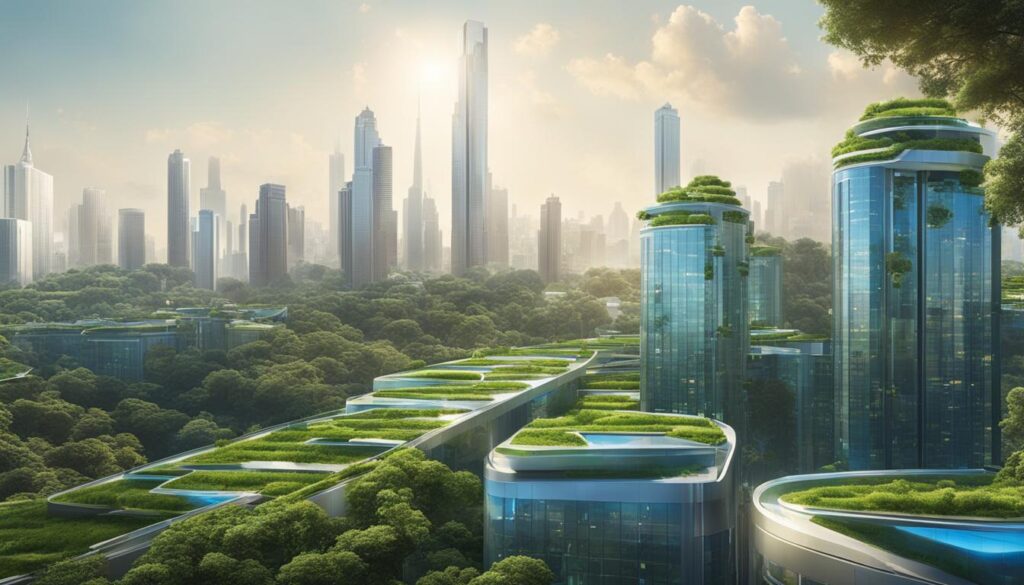G’day mates! Today, I’m going to take you on a journey through the world of environmentally sustainable design (ESD) in the beautiful Ballarat City Council. Strap yourselves in and get ready to learn about sustainable building practices, green architecture, and how Ballarat is leading the way towards a greener future.
Key Takeaways:
- ESD is transforming the way buildings are designed and constructed in Ballarat City Council.
- The council has adopted a comprehensive sustainable development framework to guide new developments.
- Energy-efficient design and renewable energy systems are key components of ESD in Ballarat.
- Green infrastructure planning plays a crucial role in creating sustainable and resilient communities.
- The council’s commitment to sustainable architecture is evident through the implementation of ESD policies and the appointment of an ESD Advisor.
Background of the ESD Policy in Ballarat City Council
The Environmentally Sustainable Development (ESD) policy adopted by the Ballarat City Council on March 22, 2023, is a significant step towards incorporating sustainable design practices into new developments. This policy aligns with Clause 15.01-2S of the Ballarat Planning Scheme and aims to reduce the environmental impact of buildings in the city.
Under the ESD policy, different thresholds are set for requiring ESD responses in various types of developments, including residential and non-residential buildings. These thresholds are based on the size and intended use of the building and are designed to ensure that sustainable design practices are implemented. The policy also outlines the assessment tools that need to be used, such as BESS, STORM, Green Star, MUSIC, and a Green Travel Plan, depending on the nature of the development.
By implementing this ESD policy, the Ballarat City Council is taking proactive steps towards creating a greener and more sustainable future for the city. The policy sets clear guidelines and requirements, ensuring that new developments in Ballarat incorporate sustainable design practices and contribute to the overall well-being of the community.
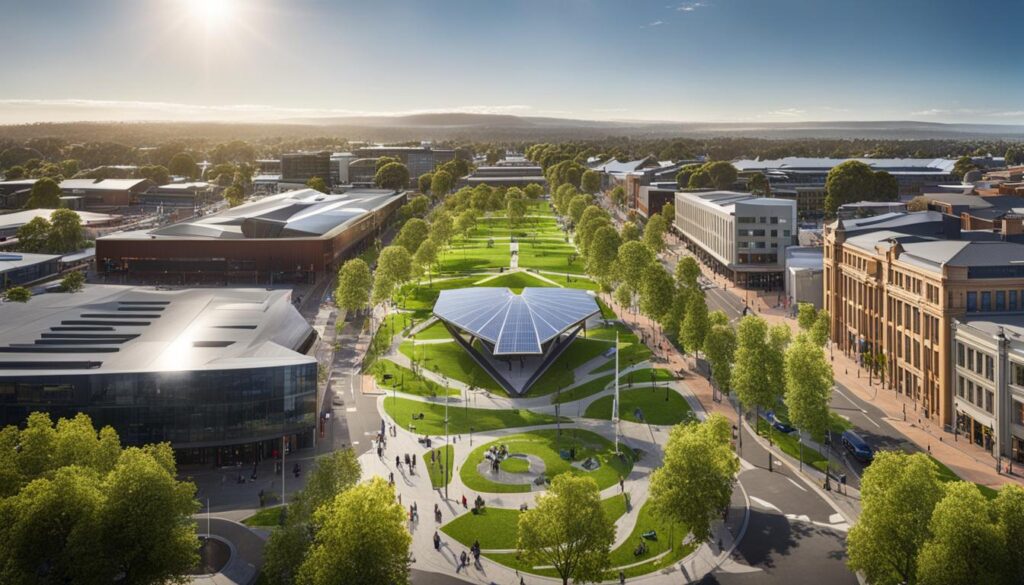
Table: ESD Policy Thresholds for Different Types of Developments
| Type of Development | Thresholds | Assessment Tools |
|---|---|---|
| Residential Buildings (2-9 dwellings) | Requires a Sustainable Design Assessment | BESS, STORM, or other agreed methods |
| Residential Buildings (10 or more dwellings) | Requires a Sustainable Design Assessment | BESS, STORM, Green Star, MUSIC, or other agreed methods Green Travel Plan |
| Non-Residential Buildings | Requirements vary based on gross floor area | BESS, STORM, Green Star, MUSIC, or other agreed methods, as applicable |
The thresholds and assessment tools outlined in the ESD policy help evaluate the sustainability performance of new developments in Ballarat. By utilizing these tools, applicants can assess the energy performance, water management, indoor environmental quality, stormwater management, and other sustainability factors of their proposed projects.
Thresholds and Tools for ESD Assessments
Fulfilling the requirements of the Environmentally Sustainable Design (ESD) policy in Ballarat City Council involves a comprehensive assessment of sustainable design practices. The policy sets specific thresholds for ESD responses in different types of developments, ensuring that sustainability is prioritized throughout the building process.
Residential buildings with 2-9 dwellings are required to undergo a Sustainable Design Assessment using tools like BESS, STORM, or other agreed methods. For buildings with 10 or more dwellings, a more extensive assessment is necessary, employing tools such as BESS, STORM, Green Star, MUSIC, or other agreed methods. In addition to these assessments, a Green Travel Plan is also required for larger residential buildings, promoting sustainable transportation practices.
Non-residential buildings follow similar thresholds and tools, with the specific requirements varying based on the gross floor area. These assessments cover various sustainability factors, including energy performance, water resources, indoor environmental quality, and stormwater management, among others. The goal is to evaluate the proposed development’s impact on the environment and identify opportunities for sustainable design.
| Development Type | Threshold | Sustainable Design Assessment Tools | Other Requirements |
|---|---|---|---|
| Residential – 2-9 dwellings | Sustainable Design Assessment | BESS, STORM, or other agreed methods | – |
| Residential – 10+ dwellings | Sustainable Design Assessment | BESS, STORM, Green Star, MUSIC, or other agreed methods | Green Travel Plan |
| Non-residential – Small | Gross floor area <1,000m2 | Sustainable Design Assessment | – |
| Non-residential – Medium | 1,000m2 <= Gross floor area < 5,000m2 | Sustainable Design Assessment | – |
| Non-residential – Large | Gross floor area >= 5,000m2 | Sustainable Design Assessment | – |
By implementing these assessments and requirements, the Ballarat City Council aims to ensure that new developments align with environmentally sustainable practices and contribute to a greener future for the community. These thresholds and tools provide a framework for developers to evaluate and enhance the sustainability of their projects, fostering a more sustainable and resilient built environment in Ballarat.
Built Environment Sustainability Scorecard (BESS) for ESD Assessments
The Built Environment Sustainability Scorecard (BESS) is a valuable tool used by the Ballarat City Council to assess the sustainability of new developments. BESS provides a comprehensive framework for evaluating various aspects of a project, including energy performance, water resources, indoor environmental quality, stormwater management, waste management, and urban ecology. This allows the Council to ensure that proposed developments meet the necessary sustainability requirements.
To use BESS, permit applicants need to register online and input the metrics of their proposed development. The tool then generates a sustainability score, which must meet the minimum requirements set by the Council’s policy. These requirements include mandatory scores in each category evaluated by BESS. The assessment helps applicants identify areas where they can improve sustainability and showcases their commitment to environmentally friendly design.
BESS Assessment Categories
The BESS assessment focuses on seven key categories that contribute to the overall sustainability of a development:
- Energy Performance
- Water Resources
- Indoor Environmental Quality
- Stormwater Management
- Transport
- Waste Management
- Urban Ecology
Within each category, the BESS assessment encourages the implementation of various sustainability initiatives. These initiatives can include energy-efficient building design, renewable energy systems, water-efficient fixtures, stormwater capture and reuse, waste avoidance strategies, and the incorporation of green infrastructure. The goal is to achieve a minimum BESS score of 50%, demonstrating a commitment to sustainable development.
Benefits of BESS
BESS provides several benefits to both the Ballarat City Council and permit applicants. For the Council, it serves as a robust and standardized assessment tool, ensuring that new developments align with sustainability goals and reduce their environmental impact. It also allows the Council to monitor progress towards broader sustainability objectives and track improvements in the built environment.
For permit applicants, BESS offers a clear framework for evaluating the sustainability of their projects, helping them identify areas for improvement and make informed design decisions. Achieving a high BESS score can also enhance the marketability of a development, as it demonstrates a commitment to environmental responsibility and sustainable practices.
Key Categories and Initiatives in the BESS Assessment
When it comes to assessing the sustainability of a development, the Built Environment Sustainability Scorecard (BESS) covers seven key categories that play a crucial role in achieving a sustainable future. These categories include energy performance, water resources, indoor environmental quality (IEQ), stormwater management, transport, waste management, and urban ecology. Each category requires specific sustainability initiatives to be implemented to achieve the desired BESS score.
In terms of energy performance, initiatives may include the use of effective shading devices, energy-efficient building fabric, and efficient heating and cooling services. Water resources can be managed through the incorporation of water-efficient fixtures and rainwater capture systems. Indoor environmental quality can be enhanced by promoting natural ventilation and ensuring appropriate air quality measures.
Stormwater management initiatives may involve the implementation of stormwater capture and re-use systems, while waste management can be achieved through waste avoidance and recycling programs. Urban ecology can be fostered by incorporating green infrastructure and promoting biodiversity within the development.
| Category | Initiatives |
|---|---|
| Energy Performance | Effective shading devices, energy-efficient building fabric, efficient heating and cooling services |
| Water Resources | Water-efficient fixtures, rainwater capture and re-use systems |
| Indoor Environmental Quality | Natural ventilation, appropriate air quality measures |
| Stormwater Management | Stormwater capture and re-use systems |
| Waste Management | Waste avoidance, recycling programs |
| Urban Ecology | Green infrastructure, biodiversity promotion |
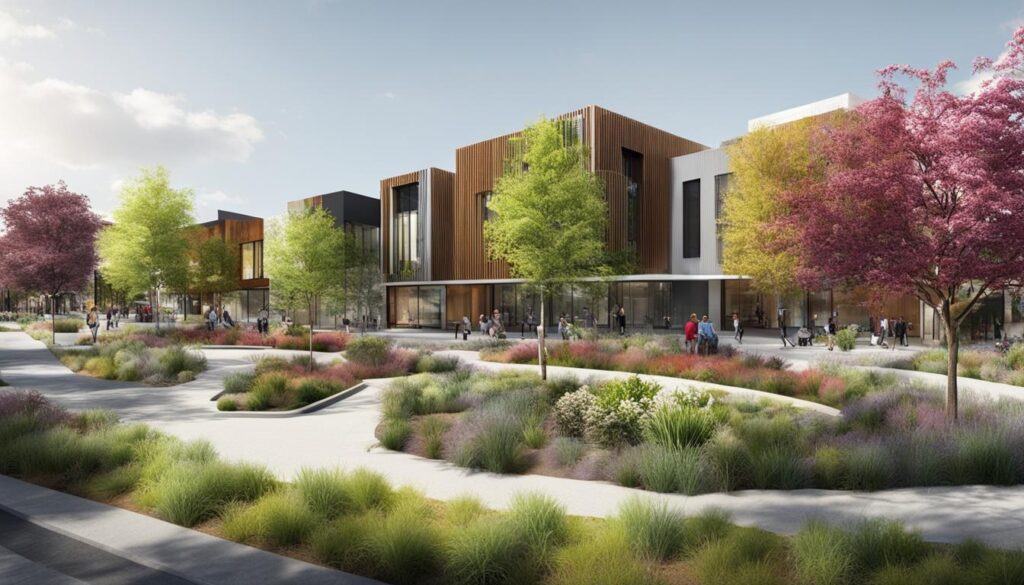
Implementing these sustainability initiatives is essential in achieving a minimum BESS score of 50%, demonstrating a commitment to creating environmentally sustainable developments. By focusing on key categories such as energy performance, water resources, indoor environmental quality, stormwater management, waste management, and urban ecology, developers can contribute to a more sustainable and resilient future.
Through the application of these initiatives, developers can not only reduce their environmental impact but also enhance the overall quality of the built environment. The integration of sustainability principles into the design and construction processes is crucial for creating buildings and communities that prioritize energy efficiency, resource conservation, and the well-being of occupants.
By adhering to the BESS assessment guidelines and implementing the recommended initiatives, developers can play an active role in shaping a sustainable future for Ballarat and contribute to the ongoing efforts to combat climate change and protect the environment for future generations.
Green Star Assessment for Larger Developments
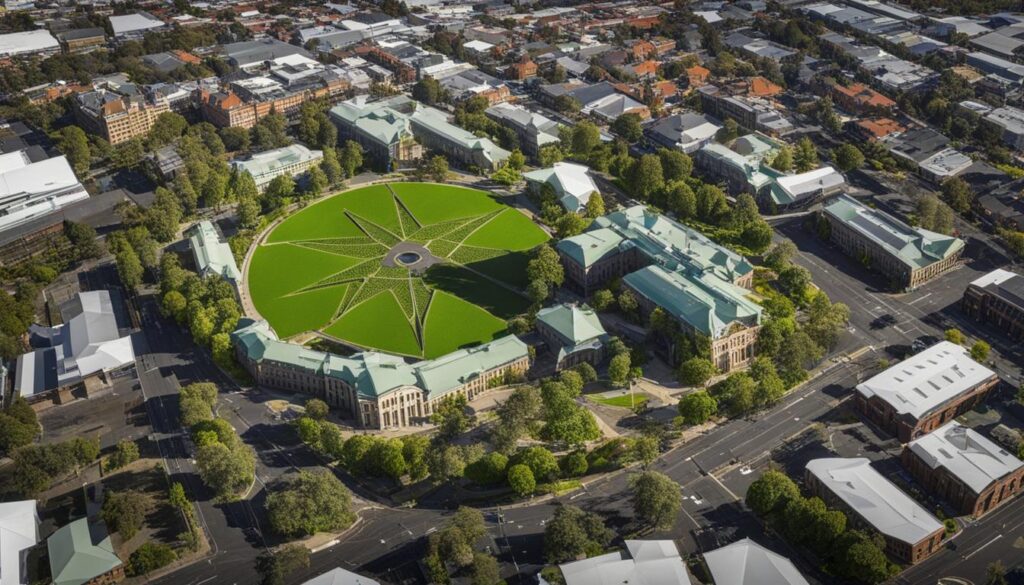
When it comes to larger developments in Ballarat, the Green Star assessment plays a significant role in ensuring sustainability standards are met. The Green Star rating system, provided by the Green Building Council of Australia (GBCA), evaluates the sustainability performance of buildings based on their design, construction, and operation. With ratings ranging from 4-Star to 6-Star, the assessment serves as a benchmark for measuring the environmental impact of these developments.
The Ballarat City Council encourages applicants to aim for a minimum 4-Star Green Star rating, although higher ratings are welcomed. Achieving a Green Star rating demonstrates a commitment to environmentally sustainable design and showcases the development’s efforts in reducing its environmental footprint. It is important to note that Green Star assessments must be registered and certified by an Accredited Professional, and equivalency assessments are not accepted by the council.
By incorporating the Green Star assessment into the development process, Ballarat City Council is taking a proactive approach to promoting sustainable design and construction practices. This ensures that larger developments in the city are aligned with environmentally sustainable goals and contribute to a greener future for Ballarat.
Benefits of Green Star Assessment:
- Provides a clear framework for measuring sustainability performance
- Promotes environmentally responsible design and construction practices
- Encourages the use of energy-efficient technologies and renewable energy systems
- Fosters innovation and sets industry-wide benchmarks for sustainable development
- Enhances the marketability and value of the development
| Green Star Rating | Minimum Requirements |
|---|---|
| 4-Star | Meets the minimum criteria for sustainable design and construction |
| 5-Star | Demonstrates a higher level of sustainability performance and innovation |
| 6-Star | Exemplifies world leadership in sustainable design and construction |
“The Green Star assessment provides a comprehensive evaluation of a development’s sustainability performance, covering various aspects of design, construction, and operation. It truly embodies our commitment to environmentally sustainable design and sets high standards for the industry. We encourage all applicants to aim for a minimum 4-Star Green Star rating, as we believe in creating a city that is not only sustainable but also offers a high quality of life for its residents.”
STORM Assessment for Stormwater Management
The STORM assessment is a crucial component of the Environmentally Sustainable Design (ESD) policy in Ballarat City Council. This assessment focuses specifically on stormwater management aspects of a development and plays a vital role in promoting water-sensitive urban design (WSUD). With increasing concerns about water scarcity and the need for sustainable water management, the STORM assessment ensures that new developments in Ballarat effectively capture and manage stormwater runoff.
The STORM assessment evaluates various factors related to stormwater management, including stormwater capture, watercourse pollution minimization, rainwater re-use, and the implementation of water-sensitive design measures like functional raingardens. By implementing these measures, the City of Ballarat aims to protect water resources, reduce the strain on existing infrastructure, and minimize the environmental impact of stormwater runoff.
Conducting the STORM assessment is a straightforward process that can be done using an online calculator provided by Melbourne Water. This calculator helps developers and planners evaluate the effectiveness of their proposed stormwater management strategies. In Ballarat City Council, achieving a minimum STORM score of 100% is required to meet the Council’s stormwater management standards and ensure the sustainable development of the city.
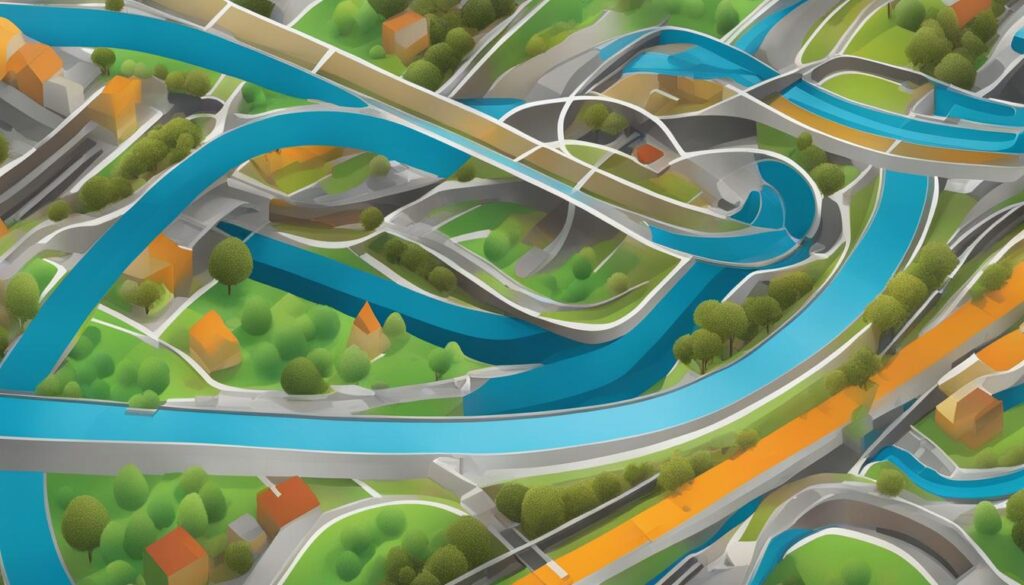
| Key Aspects of the STORM Assessment | Importance |
|---|---|
| Stormwater capture | Efficient capture and storage of stormwater to reduce runoff and prevent flooding. |
| Watercourse pollution minimization | Implementation of measures to minimize pollution of watercourses through proper stormwater management. |
| Rainwater re-use | Utilization of captured rainwater for non-potable purposes, reducing reliance on mains water supply. |
| Water-sensitive design | Incorporation of design features that promote sustainable water management and enhance the urban environment. |
In conclusion, the STORM assessment plays a crucial role in ensuring effective stormwater management and promoting water-sensitive urban design in Ballarat City Council. By incorporating sustainable stormwater management practices, the city can create a more resilient and environmentally friendly built environment.
The Role of the Environmentally Sustainable Design Advisor
As the Environmentally Sustainable Design Advisor for the Ballarat City Council, my role is to ensure the successful implementation of sustainable building practices and the ESD policy. I work closely with the planning team to provide education, support, and guidance throughout the entire development process. By promoting environmentally friendly development practices, we aim to protect the environment, improve living standards, and future-proof our communities.
One of my main responsibilities is to develop and refine the ESD controls that govern new developments in Ballarat. These controls outline the requirements and standards that developers must meet in order to comply with the ESD policy. By establishing clear guidelines, we can ensure that sustainable design principles are incorporated into every project, reducing the environmental impact and creating more resilient buildings.
Additionally, I assist in the preparation of Sustainable Design Assessments, which evaluate the sustainability performance of proposed developments. These assessments consider factors such as energy efficiency, water management, waste reduction, and indoor environmental quality. By conducting thorough assessments, we can identify areas for improvement and guide developers towards sustainable design solutions.
Through my work as the Environmentally Sustainable Design Advisor, I aim to inspire and empower developers to embrace sustainable practices. By incorporating energy-efficient design, renewable energy systems, and other sustainable features into their projects, developers can create buildings that are not only environmentally friendly but also financially viable and socially responsible. I am passionate about driving positive change in Ballarat’s built environment and ensuring a sustainable future for our community.
Table: Key Responsibilities of the Environmentally Sustainable Design Advisor
| Responsibility | Description |
|---|---|
| Developing ESD Controls | Creating guidelines and standards for sustainable development in accordance with the ESD policy. |
| Supporting Sustainable Design Assessments | Assisting developers in preparing assessments that evaluate the sustainability performance of proposed developments. |
| Providing Education and Training | Offering guidance and resources to educate the planning team and developers on sustainable building practices. |
| Promoting Environmental Sustainability | Advocating for the integration of sustainable design principles into the planning process and encouraging environmentally friendly development practices. |
The Planning Application Process in Ballarat City Council
When it comes to implementing sustainable development in Ballarat, the planning application process plays a crucial role. In line with the recently adopted Environmentally Sustainable Development (ESD) policy, the Ballarat City Council requires applicants for planning permits to undergo a Sustainable Design Assessment. This assessment helps determine how well the proposed development aligns with the 10 key sustainable building categories outlined in the policy, such as energy efficiency, water efficiency, stormwater management, and waste management.
The process begins with an assessment of whether the ESD policy applies to the proposed development based on the thresholds set out in the policy. This assessment can occur during pre-application discussions or through formal requests made by the applicant. If the policy applies, the applicant is then required to conduct the Sustainable Design Assessment using the appropriate assessment tools, such as BESS, STORM, Green Star, MUSIC, and a Green Travel Plan. These tools help evaluate various sustainability factors and ensure that the development meets the Council’s requirements.
By integrating the ESD policy into the planning application process, the Ballarat City Council is taking significant steps towards creating a more sustainable future. The Council aims to encourage developers to incorporate environmentally friendly design practices and reduce the environmental impact of new developments. Through this process, Ballarat is positioning itself as a leader in sustainable development, setting an example for other cities to follow.
Table: Sustainable Design Assessment Tools
| Assessment Tool | Applicable Development Types | Key Focus Areas |
|---|---|---|
| BESS | Residential and Non-residential | Energy performance, water resources, indoor environmental quality, stormwater management, waste management, and urban ecology |
| STORM | Residential and Non-residential | Stormwater management and water-sensitive urban design |
| Green Star | Non-residential | Sustainability performance across design, construction, and operation |
| MUSIC | Residential and Non-residential | Stormwater quality and quantity management |
| Green Travel Plan | Residential and Non-residential | Promoting sustainable transportation methods |
The Push for More Sustainable Design in Ballarat
As climate change becomes an increasingly pressing issue, the Ballarat City Council is taking proactive steps to promote more sustainable design practices. The Council, along with 23 other local governments, has submitted a Planning Scheme Amendment to the Minister for Planning, advocating for more stringent sustainability design requirements. This amendment aims to enhance the existing Environmentally Sustainable Design (ESD) requirements for new developments and better address climate change risks. Supported by the Council Alliance for a Sustainable Built Environment and the Municipal Association of Victoria, this initiative emphasizes the need to protect the natural environment, reduce resource consumption, and support the well-being of future occupants.
With the Planning Scheme Amendment, the Ballarat City Council is striving to create a built environment that is more resilient and sustainable. By integrating Environmentally Sustainable Design principles into the planning process, the Council aims to reduce the environmental impact of new developments and foster a greener future. The amendment highlights the importance of considering factors like energy efficiency, water efficiency, stormwater management, urban ecology, and waste management during the design and construction phases of new projects. By implementing these sustainability requirements, the Council seeks to create a more livable and environmentally friendly city.
The Council’s commitment to more sustainable design goes beyond just the Planning Scheme Amendment. The City of Ballarat has endorsed the Elevating Environmentally Sustainable Design project, which aims to integrate sustainable design principles into residential and commercial developments. This project, coupled with the new ESD policy and the appointment of an ESD Advisor, demonstrates the City’s dedication to creating a more sustainable and livable community for current and future residents. By focusing on sustainability, the City of Ballarat is leading the way in finding innovative solutions to combat climate change and create a better future for all.
| Planning Scheme Amendment | Council Alliance for a Sustainable Built Environment |
|---|---|
| The Ballarat City Council, along with other local governments, has submitted a Planning Scheme Amendment to enhance sustainability design requirements for new developments. | The Council is supported by the Council Alliance for a Sustainable Built Environment, which aims to protect the natural environment and reduce resource consumption. |
| Sustainability Requirements | Ballarat City Council |
| The Planning Scheme Amendment aims to introduce more stringent sustainability requirements, including energy efficiency, water efficiency, stormwater management, urban ecology, and waste management. | The Ballarat City Council is committed to creating a more sustainable and livable city by integrating Environmentally Sustainable Design principles into residential and commercial developments. |
| Climate Change | |
| The Council’s efforts to promote sustainable design are driven by the urgent need to address climate change risks and ensure a more resilient built environment. |
The City of Ballarat’s Commitment to Environmental Sustainability
The City of Ballarat is dedicated to creating a sustainable and livable community through its commitment to environmental sustainability and fostering sustainable growth. This commitment is outlined in the City of Ballarat Council Plan 2021-2025, which sets environmental goals and strategies for achieving a greener future. The plan focuses on promoting sustainable development practices and enhancing community well-being.
As part of its commitment to environmental sustainability, the City of Ballarat has endorsed the Elevating Environmentally Sustainable Design (ESD) project. This project aims to integrate sustainable design principles into residential and commercial developments. By incorporating ESD principles, the City of Ballarat seeks to create an environment that supports sustainable growth and reduces the impact on the natural environment.
“We believe that sustainable development is essential for creating a resilient and vibrant city,” says Jane Smith, Mayor of Ballarat. “Through the implementation of the ESD project and the adoption of sustainable design practices, we are working towards a more sustainable and livable future for our community.”
The City of Ballarat understands that environmental sustainability is crucial for the well-being of current and future generations. By prioritizing sustainable development and integrating ESD principles, Ballarat aims to create a community that is environmentally responsible, economically viable, and socially equitable. Through these efforts, the City of Ballarat is shaping a sustainable future for all.
I’m the ESD Champion of Ballarat City Council!
As the Environmentally Sustainable Design (ESD) implementation gathers pace in Ballarat, it’s an exciting time for sustainable building practices. The Ballarat City Council has taken a proactive stance by adopting an ESD policy that sets clear requirements for new developments. This strategic move ensures that our city is on the path towards a greener and more sustainable future.
With the ESD policy in place, developers seeking planning permits must undergo a Sustainable Design Assessment using assessment tools like BESS, Green Star, and STORM. These assessments evaluate various aspects of the proposed development, including energy performance, water resources, indoor environmental quality, stormwater management, and more. By integrating ESD principles into the planning process, we are setting higher standards for sustainable building practices and reducing the environmental impact of new developments.
Ballarat City Council’s commitment to ESD implementation is further exemplified by the appointment of an ESD Advisor. This dedicated professional plays a pivotal role in promoting sustainable development, developing ESD controls, and supporting the preparation of Sustainable Design Assessments. Together, we are driving the adoption of energy-efficient design, renewable energy systems, and efficient water management practices. With the ESD policy and the expertise of our ESD Advisor, Ballarat City Council is leading the way towards a more sustainable and livable community.
FAQ
What is the purpose of the new Environmentally Sustainable Development (ESD) policy in Ballarat City Council?
The ESD policy aims to incorporate sustainable design practices into new developments and reduce their environmental impact.
When was the ESD policy adopted by the Ballarat City Council?
The ESD policy was adopted on March 22, 2023.
What are the thresholds for requiring ESD responses in different types of developments?
The thresholds vary based on the size and intended use of the building, with different requirements for residential and non-residential structures.
What assessment tools are used for Sustainable Design Assessments?
The assessment tools include BESS, STORM, Green Star, MUSIC, and a Green Travel Plan.
How is the BESS assessment conducted?
The BESS assessment is accessed online and requires permit applicants to input the metrics of their proposed development to generate a sustainability score.
What categories does the BESS assessment cover?
The BESS assessment covers energy performance, water resources, indoor environmental quality, stormwater management, waste management, and urban ecology.
What is the purpose of the Green Star assessment?
The Green Star assessment evaluates the sustainability performance of buildings based on their design, construction, and operation.
What does the STORM assessment focus on?
The STORM assessment focuses specifically on stormwater management aspects of a development.
What is the role of the Environmentally Sustainable Design (ESD) Advisor?
The ESD Advisor assists with the implementation of sustainable building practices, develops ESD controls, and promotes environmentally friendly development practices.
What is the process for planning applications in Ballarat City Council?
Planning applications undergo an assessment to determine if the ESD policy applies, and if so, applicants need to undergo a Sustainable Design Assessment.
What is the purpose of the Planning Scheme Amendment submitted by the Ballarat City Council?
The amendment aims to enhance the existing ESD requirements for new developments and better address climate change risks.
How is the City of Ballarat committed to environmental sustainability?
The City of Ballarat has endorsed the Elevating Environmentally Sustainable Design project and has set goals for achieving an environmentally sustainable future and sustainable growth.
Source Links
- https://www.ballarat.vic.gov.au/property/statutory-planning/planning/sustainable-development
- https://www.ballarat.vic.gov.au/news/elevating-environmentally-sustainable-design-across-victoria
- https://www.ballarat.vic.gov.au/sites/default/files/2023-09/Environmentally Sustainable Design Guidelines_SEPT.pdf
